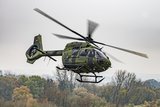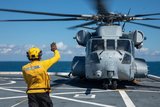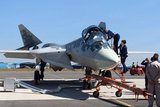Flying into the void - RN night time helicopter operations in Afghanistan
It’s the middle of the night, a few thousand feet above the Helmand ‘Green Zone’. The moon is nowhere to be seen and it’s so dark that we can’t see the line of the horizon, let alone the ground, towards which we will shortly be rapidly descending.
The other aircraft in formation appears only as three lights - the fuselage indistinct. The mind is focused; the next Landing Site (LS), somewhere in the vacuum of darkness below, is ready. The radio crackles as the Joint Tactical Air Controller confirms our clearance ‘LS is clear and secure, beware Enemy Forces operating to the North and West, you are to ingress and egress from the SE over’. This is our indication to commence the run in and the lever is lowered to initiate the tactical descent.
This is the view from the cockpit of the Royal Navy’s Sea Kings from 845 and 846 Naval Air Squadrons of the Commando Helicopter Force (CHF), working for the Joint Helicopter Force (Afghanistan) operating in Red Illum (RI). RI is classed as any night where the light levels are so low that the Night Vision Goggles (NVG) struggle to work effectively. In the UK this is not a huge issue due to the amount of cultural lighting and differing terrain, which plays well with the NVGs.
Over Afghanistan’s low contrast terrain, in RI and no ambient light, it is incredibly dark. The definition of the ground through NVG does not start to become visible until around a few hundred feet, naturally making the job somewhat trickier. Without looking through the goggles, crews are simply faced with an inky blackness, other than a few blinking lights from Camp Bastion or one of the local towns.
It is as a result of this RI condition, encountered for many of the nights in Afghanistan, that the Sea King crews, or ‘Junglies’ as they are more commonly known, have made a name for themselves. Operating in such conditions requires additional training, a slightly heightened awareness of one’s surroundings and use of techniques and equipment not routinely employed by other helicopter forces.
One such piece of kit is Display Night Vision Goggles, which were introduced to the Jungly world relatively recently. It is essentially a fast jet’s ‘head up display’ (HUD), which is mounted on the end of one tube of the NVG. It is an invaluable asset, showing essential data such as navigational information, engine performance and height. Without it RI operations would be considerably more challenging.
So we return to the Sea King pair, currently descending into the RI murk of the Green Zone. As we descend, the height is called and the crewman and door gunner respond with ‘guns outboard’.
The radar altimeter begins tracking; a quick movement of the collective lever confirms the two Rolls Royce Gnome gas turbine engines are responding correctly. As the aircraft descends to low level the ground is still not visible and the aircraft is initially levelled out. As the Patrol Base location becomes clear, the height is nudged downwards, all eyes in the aircraft trained outwards. By now, as the surrounding area becomes clearer and the definition of the LS becomes more obvious, the aircraft is manoeuvred onto a final approach for the landing. As the aircraft descends the final few feet it is engulfed in a cloud of dust thrown up by the aircraft’s downdraft.
This story is true of most nights for the Royal Navy Junglie Sea King crews. It is now standard for crews to only have a tiny percentage of day flying hours at the end of a tour in Afghanistan. Credit is to be given to the supporting engineers who work tirelessly to keep the Sea kings in the air, in conditions that range from searing heat and dust storms, to freezing cold and torrential downpours. It is no mean feat and of which the aircrew and more importantly, the ground forces that we support, are most appreciative.
Most importantly, this all goes to show the Junglies are still at the forefront of Battlefield Helicopter aviation and are an invaluable asset to not only the Joint Helicopter Force (Afghanistan), but also to the wider Royal Navy and Joint Helicopter Command.
RI operations are just another feather in the cap of the CHF and serves to remind all that this part of the Fleet Air Arm continues to support troops all around the world, from land or sea, in rain or shine, day or night, and now in RED ILLUM!
By Sub Lieutenant Fred Durrant - Fleet Air Arm
More from Defence Helicopter
-
![Germany to send WS-61 Westland Sea King helicopters to Ukraine]()
Germany to send WS-61 Westland Sea King helicopters to Ukraine
Germany has committed to sending Ukraine six of its 21 retiring WS-61 Westland Sea King multirole, amphibious helicopters.
-
![Boeing secures $271 million to advance modernisation of US Special Operations' MH-47G Chinook]()
Boeing secures $271 million to advance modernisation of US Special Operations' MH-47G Chinook
Boeing has clinched a major contract modification to further its backing of the US Special Operations Command’s MH-47G Chinook aircraft modernisation effort.
-
![Dubai Airshow 2023: South Korean homegrown helicopters make international debut]()
Dubai Airshow 2023: South Korean homegrown helicopters make international debut
Two KAI helicopters, the KUH-1E utility helicopter and the Light Attack Helicopter (LAH), have taken centre stage at the Dubai Airshow 2023.
-
![Italian Navy receives final NH90 helicopter]()
Italian Navy receives final NH90 helicopter
The Italian Navy now boasts a fleet of 56 NH90 helicopters comprising 46 SH-90As and 10 MH-90As.
-
![Argentina seeks AW109 and CH-46 Sea Knight helicopters]()
Argentina seeks AW109 and CH-46 Sea Knight helicopters
The Argentinian Air Force (FAA) and the Argentinian Naval Aviation Command (COAN) are looking for options to upgrade their helicopter fleets.
-
![DSEI 2023: Lockheed to produce about 40% of Black Hawks on UK soil if it wins NMH contest]()
DSEI 2023: Lockheed to produce about 40% of Black Hawks on UK soil if it wins NMH contest
Lockheed Martin promises a boost to the British job market and export opportunities, while strengthening ties with Poland and positioning the UK for a future in rotorcraft technology in the event of a New Medium Helicopter competition triumph.


























